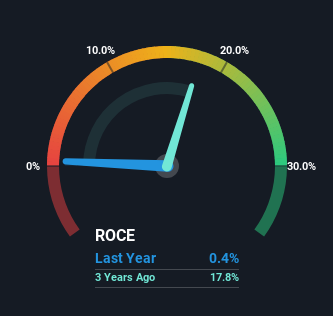What trends should we look for it we want to identify stocks that can multiply in value over the long term? Ideally, a business will show two trends; firstly a growing return on capital employed (ROCE) and secondly, an increasing amount of capital employed. This shows us that it’s a compounding machine, able to continually reinvest its earnings back into the business and generate higher returns. Having said that, from a first glance at Intel (NASDAQ:INTC) we aren’t jumping out of our chairs at how returns are trending, but let’s have a deeper look.
Return On Capital Employed (ROCE): What Is It?
For those who don’t know, ROCE is a measure of a company’s yearly pre-tax profit (its return), relative to the capital employed in the business. Analysts use this formula to calculate it for Intel:
Return on Capital Employed = Earnings Before Interest and Tax (EBIT) ÷ (Total Assets – Current Liabilities)
0.0043 = US$714m ÷ (US$193b – US$27b) (Based on the trailing twelve months to March 2024).
Thus, Intel has an ROCE of 0.4%. In absolute terms, that’s a low return and it also under-performs the Semiconductor industry average of 9.7%.
See our latest analysis for Intel
In the above chart we have measured Intel’s prior ROCE against its prior performance, but the future is arguably more important. If you’d like, you can check out the forecasts from the analysts covering Intel for free.
The Trend Of ROCE
On the surface, the trend of ROCE at Intel doesn’t inspire confidence. To be more specific, ROCE has fallen from 21% over the last five years. Meanwhile, the business is utilizing more capital but this hasn’t moved the needle much in terms of sales in the past 12 months, so this could reflect longer term investments. It may take some time before the company starts to see any change in earnings from these investments.
In Conclusion…
Bringing it all together, while we’re somewhat encouraged by Intel’s reinvestment in its own business, we’re aware that returns are shrinking. And in the last five years, the stock has given away 24% so the market doesn’t look too hopeful on these trends strengthening any time soon. On the whole, we aren’t too inspired by the underlying trends and we think there may be better chances of finding a multi-bagger elsewhere.
If you’d like to know about the risks facing Intel, we’ve discovered 2 warning signs that you should be aware of.
For those who like to invest in solid companies, check out this free list of companies with solid balance sheets and high returns on equity.
Have feedback on this article? Concerned about the content? Get in touch with us directly. Alternatively, email editorial-team (at) simplywallst.com.
This article by Simply Wall St is general in nature. We provide commentary based on historical data and analyst forecasts only using an unbiased methodology and our articles are not intended to be financial advice. It does not constitute a recommendation to buy or sell any stock, and does not take account of your objectives, or your financial situation. We aim to bring you long-term focused analysis driven by fundamental data. Note that our analysis may not factor in the latest price-sensitive company announcements or qualitative material. Simply Wall St has no position in any stocks mentioned.






